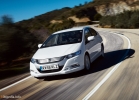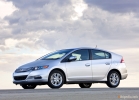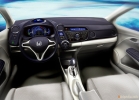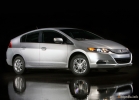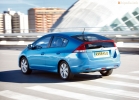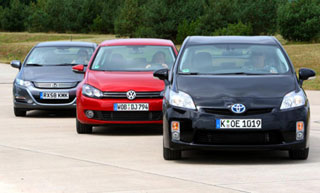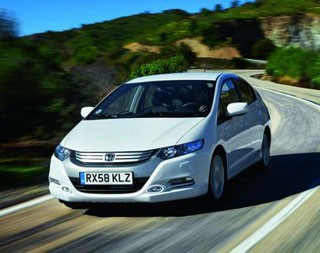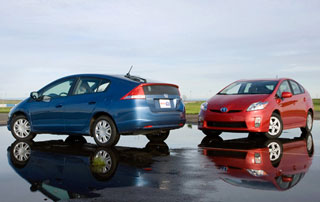Test Drive Honda Insight since 2009 Hatchback
Comparative Test: Honda Insight 2010 against Toyota Prius 2010
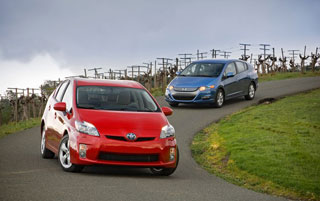 If the current economy was the same as it was a year and a half ago, when Wall Street worked for a complete, I doubt that anyone who seriously conceived about acquiring a new Toyota Prius would be to consider the new Honda Insight as an option. Undoubtedly, they are very similar, but in fact it is two completely different cars. They have different dimensions: in terms of Insight is a full-fledged representative of the CD class, while the new Prius increased in size so much that it is in time to switch to medium-sized sedans. They differ in the hybrid installation technology, and only the chemical composition of the batteries combines them. The cost will also be varied, and so much significantly that this difference can pay a pair of loan contributions. To our great regret, the economy simply took these elementary arguments, put it in a coffee grinder and pressed on the start.
If the current economy was the same as it was a year and a half ago, when Wall Street worked for a complete, I doubt that anyone who seriously conceived about acquiring a new Toyota Prius would be to consider the new Honda Insight as an option. Undoubtedly, they are very similar, but in fact it is two completely different cars. They have different dimensions: in terms of Insight is a full-fledged representative of the CD class, while the new Prius increased in size so much that it is in time to switch to medium-sized sedans. They differ in the hybrid installation technology, and only the chemical composition of the batteries combines them. The cost will also be varied, and so much significantly that this difference can pay a pair of loan contributions. To our great regret, the economy simply took these elementary arguments, put it in a coffee grinder and pressed on the start. Today, the budgets of most families are experiencing not the most better times and are subject to total reduction, and therefore the promise of almost the same fuel consumption as in Prius, but for a much smaller amount, is a weighty argument. To complicate everything, Honda made the body lines of the new Insight so similar on the body of Prius, which is a little more, and it would be possible to start a lawsuit on copyright.
Some time ago, our good acquaintance and guru of hybrid cars Dave Hermans said that the IMA system (Integrated Motor Assist) from Honda is the best solution for budget vehicles (although he immediately added that the Syrid Drive Hyrid DRIVE system is more suitable for larger and expensive models). So, Honda finally lowered the trigger and brought the world the most terrible nightmare concern Toyota.
Insight is a car whose purchase would approved your accountant, and after reading your catastrophic report on pension contributions even strongly recommended. Imagine that on 24 dollars, which were spent on filling a full gasoline tank, you can drive 700 km. You are already interested, right? Under the base value of $ 20,470 and the expected flow rate of 5.73 liters per 100 km in mixed mode, Insight should be an impeccable financial shelter, where it will be possible to hide from the begging economy and growing oil prices. Whatever the collapse happens, you will be worthily surviving him in my insight.
 There will be no problems and Honda. Insight is charged with a winning combination of a 88-strong 1,3-liter row 4-cylinder gasoline engine with a 13-strong electric motor masking under the flywheel, such technical equipment, at first glance, may seem typical payment for the IMA system. But it is not. Honda engineers simply sturped on the details, trying to reduce the cost wherever only possible: something was reduced in size, removed the three-phase I-VTEC system from Civic Hybrid, halved reduced the cost of the pistons and reduced batteries. As a result, the Insight Hybrid Premium equipment has become 40% cheaper than Civic Hybrid. Cool.
There will be no problems and Honda. Insight is charged with a winning combination of a 88-strong 1,3-liter row 4-cylinder gasoline engine with a 13-strong electric motor masking under the flywheel, such technical equipment, at first glance, may seem typical payment for the IMA system. But it is not. Honda engineers simply sturped on the details, trying to reduce the cost wherever only possible: something was reduced in size, removed the three-phase I-VTEC system from Civic Hybrid, halved reduced the cost of the pistons and reduced batteries. As a result, the Insight Hybrid Premium equipment has become 40% cheaper than Civic Hybrid. Cool. Unfortunately, the cost reduction is felt on the road. In addition to road noise (its level exceeds the one with which you expect to face in the car with a price tag that has not reached $ 20,000) you will clearly hear how a small engine is maintained, especially if you press gas. And the suspension is not so soft, which was immediately marked by my three-year-old passenger, seated in a children's chair: Dad, you go too hard! This is all the car, son, it's all the car.
Many of us were surprised when the Insight consumption data was officially published, since it turned out to be higher than at Honda Civic Hybrid with its oldest technologies (5.88 / 5.22 l per 100 km from Civic, 5.88 / 5, 47 Insight). Who's guilty? Most likely, the refusal of the three-stage mechanism of I-VTEC in favor of a rolled up to the budget limit played a role. Nevertheless, we are completely puzzled by the insight frontal resistance coefficient, which, one way or another, is somewhat lower than that of Civic.
The third generation prius is a powerful step in the direction scheduled for this model. The characteristic appearance of the prius remained unchanged, except for the shift of the highest point of the arches of the roof closer to the rear, which made it possible to increase the space above the heads of the rear passengers. The bottom of the body is almost smooth, not counting the two strange type of protrusions in the area of \u200b\u200bthe rear axle. What are they for? We were told for a course stability (information on the note is a twin rival: we will have to check whether Prius will lose course stability without these fins).
Aerodynamic flowability is combined with clear vertical bends in the back of the body, which work as a removal for air flow. Insight does not have this, and therefore there is one bad angle. In addition, the new prius is beautiful. I doubt that it will become the object of many car jokes. Inside the prius, it became more spacious: now in the cabin 2.8 cm more space for the front passenger's shoulders and driver, 0.76 cm is more space for the heads of the rear passengers, and 2 cm for their knees. It is very spacious here, in contrast to the close back of the insight salon, where the 14-year-old teenager can be accomplished.
 Under the hood, Prius meets us 90% updated engine, and all that was previously higher than your understanding, still there, it was even better. Changes begin with a working volume of 1.8 instead of the previous 1.5 liters, and contrary to your expectations, this replacement contributes to the cost effectiveness, since the engine does not need to be widely unwind, it is also perfectly drawn at lower revs. The main electric motor Prius also became more powerful, although it decreased in size due to the appearance of a planetary transmission, which allows the motor to rotate faster, increasing its torque. Two other changes to the planetary transmission (instead of a chain) connecting the motor with differential, and the dirtless drive of the water pump and the air conditioner compressor (it now has a new feature, you can start the air conditioner from the key fob, without the need to start the engine). Also, a thermos who used to drive a hot refrigerant through a block when the engine was muffled, replaced on the nozzles across the exhaust system.
Under the hood, Prius meets us 90% updated engine, and all that was previously higher than your understanding, still there, it was even better. Changes begin with a working volume of 1.8 instead of the previous 1.5 liters, and contrary to your expectations, this replacement contributes to the cost effectiveness, since the engine does not need to be widely unwind, it is also perfectly drawn at lower revs. The main electric motor Prius also became more powerful, although it decreased in size due to the appearance of a planetary transmission, which allows the motor to rotate faster, increasing its torque. Two other changes to the planetary transmission (instead of a chain) connecting the motor with differential, and the dirtless drive of the water pump and the air conditioner compressor (it now has a new feature, you can start the air conditioner from the key fob, without the need to start the engine). Also, a thermos who used to drive a hot refrigerant through a block when the engine was muffled, replaced on the nozzles across the exhaust system. On the road two of these cars, like the sky and the earth. At the wheel of Insight, you have to reach the radio regulator, whereas in Prius is much quieter than in its predecessor. And in general, it felt solidity, confidence and quality characteristic of LEXUS models, which unequivocally play Lexus HS 250H hand, which will be created on the basis of Prius.
A significant difference between the two cars in terms of noise and vibration insulation, which is interesting, mirroredly reflected in the difference in the design of their interiors. If the front panel Insight is a real rue (as if the designers have cut it with a machete), then in prius it is restrained and smooth. Even the solid plastic surfaces look surprisingly soft.
Among the numerous beautifully decorated graphic mappings, one struck us most: playing buttons on the steering wheel.
One touch to any of these buttons includes this display, and the press makes it brighter. Even the I-Drive system at BMW has something to learn here from the point of view of ergonomics. If we talk about innovations, then in the prius they are everywhere, including a finalized parking assistance system, borrowed from Lexus LS, a radar collision prevention system (including automatic braking) and a roof solar panel, which is provided with an energy fan, driving through the interior of fresh air, When the car stands in the parking lot. I can also confirm that the system that follows the position of the car on its lane is working quite efficiently, although I do not recommend that you check it (I turned on signs and the left wheel of Prius hit the markup line).
 New for Prius 2010 are the buttons that activate three modes of operation. Pure EV mode is trying to move the inclusion of a gasoline engine to reach a speed of 40 km / h (however, any sharp pressing on the gas pedal will immediately wake it up). ECO mode smoothes sharp press on the accelerator and reduces the degree of opening of the throttle by 11.6%. And POWER mode, on the contrary, increases the degree of opening of the throttle, especially in the average range of revolutions. Strange, but INSIGHT accelerates to 100 km / hour a little faster, 10.4 versus 10.6 seconds, despite the worst ratio of mass to power.
New for Prius 2010 are the buttons that activate three modes of operation. Pure EV mode is trying to move the inclusion of a gasoline engine to reach a speed of 40 km / h (however, any sharp pressing on the gas pedal will immediately wake it up). ECO mode smoothes sharp press on the accelerator and reduces the degree of opening of the throttle by 11.6%. And POWER mode, on the contrary, increases the degree of opening of the throttle, especially in the average range of revolutions. Strange, but INSIGHT accelerates to 100 km / hour a little faster, 10.4 versus 10.6 seconds, despite the worst ratio of mass to power. Although the semblance of EV mode in Insight consists mainly in turning off the gasoline motor at idle, it can still accelerate to 48 km / h due to the 13-strong electric motor, while the engine valves are tightly closed to avoid energy consumption on the operation of the fuel pump. The same chip with the closure of the valves is very often observed when braking and on descents, it is noticeable even at a speed of 110 km / h if you release the gas pedal. Era defines for Prius fuel consumption in mixed mode for the United States at 4.7 liters per 100 km (4.7 liters in the city, 4.8 liters on the highway), which is confirmed by testing on the test track, designed toyota, where Prius with showed The consumption of 4.52 liters per 100 km (which is curious, on the same highway Insight demonstrated 5.11 l, which is much better than the results of Era).
It would seem that the easier insight should break the opponent in terms of controllability, but the weak gear ratio of the steering mechanism (3.3 turns from the stop before the stop) and the minimum force on the steering wheel playing the arm heavier prius, with a more sensitive steering wheel (which, It should be noted, equipped with optional 17-inch wheels). Compensates this is a perfectly configured CVT variator with 7 conditional transmissions switched using submissive petals.
 So, you probably think that I find several flaws in Insight and not finding any in Prius, we easily identified the default contest winner. Actually, yes, Prius definitely retains the title of king among hybrids. This is a very impressive car in which the best engineering solutions in the field of automotive are concentrated. If he is on your pocket, buy.
So, you probably think that I find several flaws in Insight and not finding any in Prius, we easily identified the default contest winner. Actually, yes, Prius definitely retains the title of king among hybrids. This is a very impressive car in which the best engineering solutions in the field of automotive are concentrated. If he is on your pocket, buy. But what else is important for a hybrid? Let's go back to the issue of value. Despite the fact that Prius will undoubtedly inherit such promising technologies as lithium batteries and may be able to recharge from the network, all this in the future. Not now. When both of these cars go on sale, the difference in the cost will be at least $ 3,000.
The cost of Insight, consuming an average of 5.7 liters per 100 km, starts with $ 20,000, which makes it the first hybrid car, which is simultaneously available to almost everyone and at the same time is a profitable project for its creator. Surprisingly, its consumption is almost identical to the 2nd generation prius, but in just 85% of the value of the latter. The advantage of 4.7 liters over 5.7 liters per 100 km does not matter whether you are judging from the cost of gasoline, national security indicators or a decrease in CO2 emissions of the CO2 on the background of the sales level forecast. This is the cornerstone, which will be listed in the Annala history.
1st place
Honda Insight
The imperfect car, noisy and hard, as well as perhaps the most important hybrid of all ever created.
2nd place
Toyota Prius.
The world's best hybrid car gained solidity and refinement, as well as became even more economical. This is a triumph of engineering thought, worthy of enhancing in textbooks.





A source: Motortrend.
Video Test Drives Honda Insight since 2009
Video crash tests Honda Insight since 2009
Test drives Honda Insight since 2009
Crash Test Honda Insight since 2009
Crash Test: Details90%
Driver and passengers
76%
Pedestrians
74%
Children-passengers
86%
Active security system

